Deaconfield Beagles
HISTORY
How it all began
The kennel really commenced when she obtained Stanhurst Rachel from Mrs Oldman of Barsheen Bloodhounds. Rachel was mated to Ch Barvae Statute producing Ch Deaconfield Rebecca in 1958 (10 CCs). Rebecca produced Ch Deaconfield Ripple when mated to Ch Barvae Paigan. This combination was repeated in 1962 producing Ch Rossut Deaconfield Ravish and Deaconfield Regan. Regan stayed at Deaconfield and Ravish was successfully campaigned by the Suttons.
 Ch Deaconfield Rebecca
Ch Deaconfield Rebecca Ch Deaconfield Rampage Also winner of Beagle Club Working Certificates
Ch Deaconfield Rampage Also winner of Beagle Club Working CertificatesRipple to Ch Dialynne Huntsman produced Ch Deaconfield Renown. Ripple won the Bitch CC at Crufts in 1962.
 Ch Deaconfield Renown winning the DCC at Hove Championship Show in 1966
Ch Deaconfield Renown winning the DCC at Hove Championship Show in 1966 Ch Deaconfield Random winner of 6 CCs and 6 RCCs
Ch Deaconfield Random winner of 6 CCs and 6 RCCs Sylvahue Riot from Deaconfield
Sylvahue Riot from Deaconfield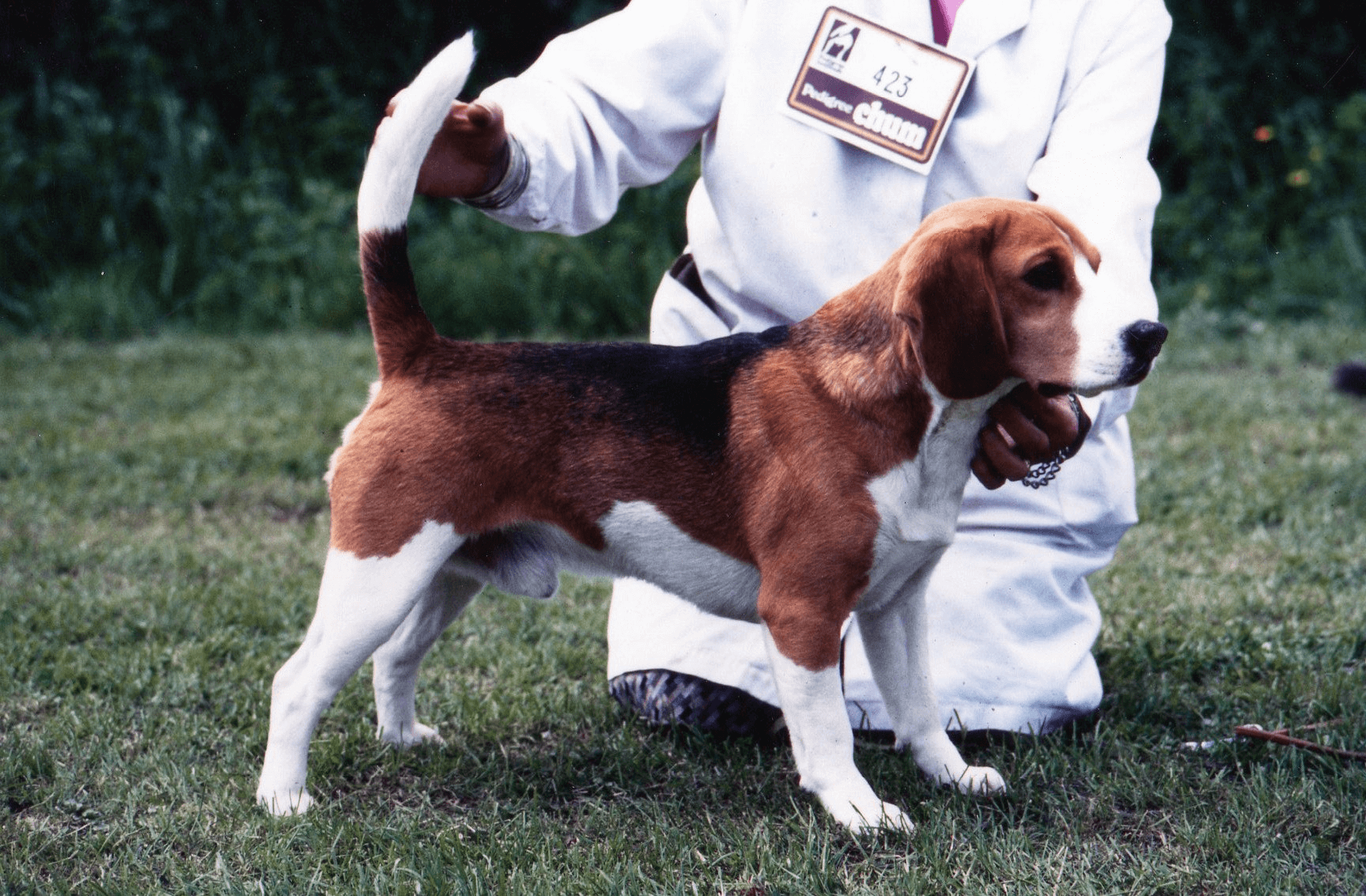 Deaconfield Rampant winner of 2 CCs
Deaconfield Rampant winner of 2 CCs
WELCOME TO DEACONFIELD BEAGLES

We are a small kennel of Beagles living in Worcestershire, UK and exhibit our hounds at Open and Championship Shows across the UK. Occasionally we have puppies for sale to good homes.
All hounds are tested MLS, NCCD & Lafora epilepsy clear.
PLEASE BEWARE......A POLITE NOTE TO POTENTIAL PUPPY BUYERS FROM WEST MERCIA BEAGLE CLUB ....
IT HAS COME TO THE ATTENTION OF MOST OF THE UK BEAGLE BREED CLUBS THAT THERE HAS BEEN AN UNPRECEDENTED SURGE IN NEW PUPPY ENQUIRIES OVER THE LAST MONTH OR SO......and at the moment there are not enough puppies to meet this demand which in turn is leading to us being informed of a number of scams.
AS A BEAGLE BREED CLUB WE ARE NATURALLY BECOMING INCREASINGLY CONCERNED ABOUT THE NUMBER OF REPORTED SCAMS …..WE ARE SEEING BUYERS BEING ASKED TO PAY A EXTORTIONATE PRICE FOR AN ON LINE PUPPY THAT NEVER ARRIVES.
Reputable beagle breeders who are selling K.C. registered puppies will not be looking to charge greatly increased prices for their puppies, and prospective puppy owners need to spend time researching the beagle breeder where possible.
Anyone wishing to buy a puppy should firstly check the ‘ Find a Puppy’ section on the official Kennel Club web site…. https://www.thekennelclub.org.uk/services/public/findapuppy
There are breed clubs that cover the whole of the U.K that have information on their web sites regarding beagle puppies, along with points to help you decide if a beagle is suitable for your family. Our own website is www.westmerciabeagleclub.co.uk and there are links on our website to the other beagle breed clubs websites. Also on the website is West Mercia Beagle Club’s Code of Ethics which is the minimum standard expected from breeders. And a link to Beagle Welfare, the breed’s own charity, on which you can find some excellent reading material.
Please take time to do a little research into the breed – it’s a big decision that’s not to be rushed.
Stay safe
Older puppies and adults sometimes available to
loving permanent homes
You can contact me,
Debbie Taylor, at:
debbie_deaconfield@outlook.com
Telephone number 01905 345755

DEACONFIELD HOUNDS - PART 1
Mistylaw Nomad from Deaconfield arrived in Worcestershire from the famous Mistylaw Kennels in Scotland, along with a companion. Little did I know how much my life was about to change!


The highlight of Bonnie's career was winning RCC at Crufts 1999 under breed specialist the Late Mrs Honor Eades.




Pictured below left is Deaconfield Flourish (the tan and white), Duet's daughter by Ch Nedlaw Barbarian. She is currently taking time out of the ring and trying her paw at agility. One of us isn't as fit as we first thought!!

From Duet's litter in 2009 to Ir Ch Kenzed Weaver of Bondlea we retained a tan and white dog, Deaconfield Fluter, and a tri-colour bitch, Deaconfield Folksong. Both qualified for Crufts in 2011 with Fluter (Alfie) being placed.
Fluter has become a sofa beagle and gone to live with Tia down near Bristol. He is enjoying long walks on the Mendips where he can run free and have lots of fun.


DEACONFIELD HOUNDS - PART 2

Zoe with her friends on 'holiday'

New Additions to the Show Ring have made a promising start to their show careers

(a repeat mating of Gaiety)
Photos: S&S Productions



From the second litter we retained Deaconfield Harmony in October 2014, a pretty broken tri bitch sired by Dufossee Ikea. Flora (Folksong) having retired now resides in Leamington Spa.

 Ch Deaconfield Kingcraft
Ch Deaconfield Kingcraft Deaconfield Keepsake
Deaconfield KeepsakeWhen Newlin Perth at Molesend was mated to Deaconfield Jasmine (by Ch Rossut Endeavoured ex Deaconfield Harmony) we got Deaconfield Listener (a tan and white dog) and Deaconfield Lively (a tri-colour bitch). Unfortunately, shortly after they were old enough to show the Covid-19 pandemic took centre stage but not before Kingcraft was awarded two RCCs.
Following Covid Kingcraft and Keepsake were successfully shown with Kingcraft gaining additional RCC's under many breed specialists. In October 2023 at Midland Counties CS Championship show Kingcraft was awarded his first Challenge Certificate under breed specialist Mr Darren Fellows (Rosanka).
In November 2023 Deaconfield welcomed two new additions Rosanka O'Neal and Rosanka Harlow both sired by Deaconfield Kingcraft ex Rosanka Midler. Both tan and white. At their first Championship show at Devon, Cornwall & SW BS in May 2024 O'Neal aka Ronnie was awarded the RCC.
This June (2025) we made a journey up to Scotland and attended two championship shows. At Border Union Kingcraft was awarded his second CC and BVIB under Miss Lynn Bailey (Salenko). He was awarded Veteran Gp3. I was floating but more was to come .......
The following day at Scottish Beagle Club under Mr David Craig (Davricard) Kingcraft was awarded his third CC ..... he was now a champion!! Also Best Veteran in Show. I'm delighted that his many virtues have been recognised and rewarded. Currently he has 3 CCs and 8 RCCs and Ch in front of his name. O'Neal also won his classes at both shows. I floated home from Scotland and the journey home didn't seem so far.

PUPPIES
THE PUPPIES HAVE GONE TO THEIR FOREVER HOMES.
If you are interested please complete the puppy questionnaire and forward to me using the email below.


If you are interested please complete the puppy questionnaire and forward to me using the email below.
PLEASE Click Here TO ACCESS THE PUPPY QUESTIONNAIRE
AND EMAIL TO ME AT debbie_deaconfield@outlook.com
Occasionally we have puppies available to good homes. If you think you have the time and commitment for a Beagle puppy to join your family, please contact me.
Adding a puppy to the family is a very serious decision.
Do NOT get a puppy if:
You are busy running the kids to practice and events and appointments, or have many social engagements, or are seldom home for whatever reason.
You do not have a sense of humour!
You have a very set expectation about what a puppy should act like, or what he should be like when grown.
You are intolerant of messes or destruction to a certain degree.
Anyone in the family does not want a puppy/dog.
You are not able to be the leader and teach the puppy to follow the rules of the household.
You value orderliness in your household and having muddy paws or shedding hair or teeth marks will bother you a great deal.
You are not willing to work through the problems, and spend time training and just loving your dog.
A member of the Kennel Club Assured Breeder Scheme, all puppies go to their new homes with a Puppy Sales Pack which includes:
- Kennel Club Registration Document
- Five Generation Pedigree
- Sales Contract
- A week's supply of Puppy food
- Five weeks free KC Insurance
- Written advice on all aspects of puppy rearing including feeding, vaccination, worming and training
- First vaccination - your vet will need to administer the second vaccination to complete the course
- Micro-chipped
- Support and Advice throughout the dog's life.
If you would like further information about this litter or the breed generally,
please send me an email/give me a call on 01905 345755.
PLEASE Click Here TO ACCESS THE PUPPY QUESTIONNAIRE
AND EMAIL TO ME AT debbie_deaconfield@outlook.com
*****************************************
Pictures of some previous litters below
May 2017
Deaconfield Harmony's litter to Ch Rossut Endeavoured,
three dogs and three bitches


The Boys

The Girls
************************************************
The Sire is Ch Dialynne Masterpiece
AND THE DAM:
Deaconfield Flourish (left)


 and Four T/W Bitches
and Four T/W Bitches

At the milk bar with Mum
Just over a week old below

Tri Dog and Bitch

T/W Bitches
************************************************
and Deaconfield Folksong with her litter
The Sire is Champion Dialynne Musketeer
THE DAM: 
Deaconfield Folksong
Puppies born 15 January 2012
Five Tri Dogs

Seven Tri Bitches

************************************************
Pictures of puppies from previous Deaconfield litters ......
Milly's puppies in 2010




*****************************************
Duet's puppies in 2009



Tucking into puppy food and cutting teeth

************************************************
First day out on grass - interesting stuff!








************************************************
Deaconfield Bellmaid aka Bee's Puppies in 2005


************************************************
Duet's puppies in 2008


The t/w is Deaconfield Flourish
GALLERY


 Summer has achieved her Kennel Club Gold Citizen Award and has recently commenced Agility Classes
Summer has achieved her Kennel Club Gold Citizen Award and has recently commenced Agility Classes

 Tilly has achieved her Kennel Club Silver Citizen Award and is a showgirl in the ring
Tilly has achieved her Kennel Club Silver Citizen Award and is a showgirl in the ringSome litter mates from Duet's litter in 2009
 Drew and her friend Hector
Drew and her friend HectorBramble ready for her boating trip!

 Basil enjoying the wide open spaces!
Basil enjoying the wide open spaces! Freddie as a puppy
Freddie as a puppyOLDER HOUNDS

Older Hounds
If you think that you can offer a loving, caring home to a Deaconfield Beagle, please contact me to discuss further. Obviously, your life style and the Beagle involved need to be suited to each other.
Older puppies and adults sometimes available to loving permanent homes
In the first instance please email me attaching your completed questionnaire - thank you.
KC INSURANCE

Kennel Club Insurance
It's important to be aware that not all pet insurance is the same. Some policies limit the amount of time or money that you can claim for. Don't just shop around on price alone. I provide an introduction to KC insurance.
Click here: The Kennel Club Pet Insurance
BEAGLE HEALTH

More details may be found on the Beagle Health website Beagle Health Website
Beagles are medium sized, short haired dogs with no exaggerated features of conformation. They have a merry disposition and are very sociable, which makes them popular as family pets. They were originally bred to hunt hare and think for themselves. This gets them into trouble at times as they follow their noses to find food or other exciting, usually unsuitable, things to eat, often resulting in an upset digestive system. Anyone who owns a beagle needs a good sense of humour.
Our website www.beaglehealth.info talks about canine health in general, as well as conditions that are specific to beagles and includes discussions about the ones we feel are the most important. An internet search for beagle health matters may bring up an alarmingly long list of diseases and conditions, but the beagle is unique in being used for research and there are many thousands of papers published from this. Many of these are obscure and may relate to the laboratory population, which has become genetically selected.
Good breeders DNA test their beagles for the main conditions that may occur in pet and show beagles. This means they have done their best only to breed from healthy parents. At the moment the four conditions most likely to be debilitating in affected beagles are MLS, NCCD, IGS and Lafora’s Disease, plus a fifth that appears to be less of a problem: FVII deficiency. These are all recessive conditions and are explained in more detail on the website. Briefly each dog carries two copies of the relevant genes, with one inherited from each parent. An affected beagle has two bad copies and will be affected by the condition. A carrier (one copy only) or a clear dog (no copies) cannot get the disease and will lead a normal life as far as these conditions are concerned. To avoid affected puppies, anyone breeding must know the dog’s status, as carriers of the first four can only be bred to a clear dog.
Lafora’s Disease is our newest test (released at the end of 2017) and is a slowly progressive metabolic condition, ultimately leading to neurological signs and seizures. In some ways this is one of the most important as it is not visible until the beagle is a few years old. Thus the beagle could have been bred from prior to symptoms showing. We hope all breeders will take this on board and we will have no puppies from unscreened parents in the near future.
Musladin-Lueke Syndrome (MLS) is a condition that results in several visible physical deformities as well as other issues, such as early arthritis and seizures in some cases. This was the first condition we started screening for and we now have many hereditarily clear beagles in the UK. Along with Neonatal Cerebellar Cortical Degeneration (NCCD) these have been recorded for many years and there is really no excuse for breeders not to screen for them. NCCD produces a coordination problem visible by a few weeks of age and affected beagles cannot control their hind legs properly. Both these conditions must be tested for under the UK Kennel Club Assured Breeders Scheme.
FVII is one of the chemicals involved in blood clotting. Fortunately it seems to be a minor condition in most beagles, as many affected dogs have surgery without any issues. However if a dog was compromised in some way it is wise to be aware of its status.
September 2018 Pictures by Kath Parkin

Information about when to neuter your dog / bitch can be read below:
By Samantha Goldberg BVSc MRCVS
The following article is a review of current literature and discussion about the perils of early neutering.
Beagles are a medium sized breed and age of maturity of the skeleton particularly bigger bones is at least 12 months. Testosterone and oestrogen are involved in some of the long bone formations in the body so removing this too early can affect correct growth leading to prolonged growth and poorer quality bone with abnormal mechanical behaviours of the joints (1). Early neutering –ie before skeletal growth has finished results in taller leggier hounds as the closure of the plates in the long bones is helped by release of puberty hormones. There is also increased risk of cranial cruciate rupture, intervertebral disc disease, hip dysplasia and patella luxation being cited in some breeds. The number of breeds listed as affected is likely to increase as we know more.(2-6)
Bitches may be sexually mature before the body has finished developing physically and mentally. Although they may be able to come into season they have not finished growing if under 12 months and will certainly not have finished maturing mentally. Beagles will generally come into season when they have reached at least 6 months of age but there is a big variation and some will be 18 months before they reach sexual maturity. Some families genetically are later than others and it is best to be patient and not just neuter to suit the human family. The season is only three weeks and a well crate trained beagle can cope with plenty of chews and walks on a lead where the number of other dogs is low.
Many vets will try to influence owners to spey their bitch at 6 months and often before a season. There was a paper (7) published many years ago looking at mammary tumour development in bitches who had cycles. The table below lists the number of dogs included which can be seen to be very low-24 in total. The risk pre season is based on one bitch only and shows neutering between 1st and 2nd season is still over 90% protective. (note the bottom two lines of the table are the bitches from the third line portrayed in a different way).
Before 1st Season 0.5% 1
Between 1st and 2nd season 8% 3
2 or more seasons 26% 20
2 or more seasons but <30months old 6% 2
2 or more seasons but > 29 months old 40% 18
Their study is widely quoted and there is no doubt that repeated cycles do increase the risk as this is shown in countries where neutering is not routinely practiced such as Scandanavia. However allowing one season allows many other very important health issues to be reduced.
As vets in prepubertal bitches we commonly see cystitis, irritation around the vulva and yellow/greenish vaginal discharges, which resolve once the bitch has had a season. The prepubertal vulva is very small and often recessed allowing skin irritation in the fold.
Urinary incontinence is more common in neutered bitches. In fact one of the treatments for this is a low daily dose of oestrogen supplement. The incontinence is caused by sphincter mechanism incompetence (SMI) which basically means the tissue closing the neck of the bladder and which allows urination under control becomes weak and involuntary urination occurs. A study (8) of over 333,000 records using Vetcompass (an anonymised system which allows review of UK veterinary practice records) showed an 3 times increased risk of neutering and increased weight for SMI. Dogs over 10kg have an increased risk. This applies to general body weight as well as obesity. In other words keeping your dog slim is essential. There are not many beagles under 10kg mature correct body weight but keeping them fit is a great help. SMI in male dogs is not very common and weight control in males is needed for other reason.
Beagles are a breed bred to think for themselves whilst out hunting. Thus they may be harder to recall and often get distracted when off lead, making yourself more interesting than a hare is difficult! Neutering will not alter this! In male beagles one of the commonest things I hear is “he runs off” “I think he is looking for bitches”. Actually it is highly likely that dog is also hunting and this is not driven by testosterone. A heedless teenage beagle is best trained first and then neutered.
Teenage beagles generally need consistent guidance on how they fit in the family pack. If they are neutered too young that behavior can become fixed as they need to come out of puberty to be mentally mature. There is a lot of work looking at behavioural issues with dogs in rescues and when they were neutered. So far it seems likely that more dogs ending up in rescue with behavioural issues were neutered early-ie under 12 months.
Neutering reduces metabolic rate and this means they need fewer calories or more exercise to balance it. Often neutering is carried out without the vet warning the owner of this. Thus we hear “she is overweight because she is speyed”. Actually not true-being overweight is cause by eating more calories than are expended. Overweight dogs have higher risks from many health condition-diabetes mellitus, joint issues both due to increased mechanical strain and also inflammatory mediators released the higher fat levels, and obvious things such as heart disease due to increased work load.
Neutering male dogs directly reduces risks of increased prostate size due to testosterone (not the same as tumours) and in bitches removes the risk of pyometra a life threatening uterine condition and ovarian cancers. These effects are very positive.
To summarise neutering should be carried out at the correct time to maximize health in your dog and afterwards their life style may be changed a little eg calorie control. Neuter to reduce risks of many health conditions but do it at the right time to maximize the longevity of your beagle.
1. Salmeri KR, Bloomberg MS, Scruggs SL, Shille V. Gonadectomy in immature dogs: effects on skeletal, physical, and behavioral development. J Am Vet Med Assoc 1991;198(7):1193-1203.
2. Slauterbeck JR, Pankratz K, Xu KT, et al. Canine ovariohysterectomy and orchiectomy increases the prevalence of ACL injury. Clin Orthop Relat Res 2004;Dec(429):301-305.
3. Whitehair JG, Vasseur PB, Willits NH. Epidemiology of cranial cruciate ligament rupture in dogs. J Am Vet Med Assoc 1993;203(7):1016-1019.
4. Torres de la Riva G, Hart BL, Farver TB, et al. Neutering dogs: effects on joint disorders and cancers in golden retrievers. PLoS One 2013;8(2):e55937.
5. van Hagen MA, Ducro BJ, van den Broek J, Knol BW. Incidence, risk factors and heritability estimates of hind limb lameness caused by hip dysplasia in a birth cohort of boxers. Am J Vet Res 2005;66(2):307-312.
6. Vidoni B, Sommerfeld-Stur I, Eisenmenger E. Diagnostic and genetic aspects of patellar luxation in small and miniature breed dogs in Austria. Eur J Comp Anim Pract2005;16(2):149-158.
7. Schneider R, Dorn CR and Taylor DON (1969) Factors influencing canine mammary cancer development and postsurgical survival. Journal of the National Cancer Institute 43, 1249-1261.
8. Pegram, C. , O'Neill, D. G., Church, D. B., Hall, J. , Owen, L. and Brodbelt, D. C. (2019), Spaying and urinary incontinence in bitches under UK primary veterinary care: a case–control study. J Small Anim Pract. doi:10.1111/jsap.13014
LINKS
You may find the following links useful.
Breed Clubs
The Beagle Association - http://beagleassociation.org.uk
The Beagle Club - www.thebeagleclub.org
Northern & Midland Counties Beagle Club - www.nmcbc.co.uk
Southern Counties Beagle Club - www.southerncountiesbeagles.com
The Four Counties Beagle Club - www.fourcountiesbeagleclub.co.uk
The Scottish Beagle Club - www.scottishbeagleclub.org.uk
Welsh Beagle Club - www.thewelshbeagleclub.co.uk
West Mercia Beagle Club - www.westmerciabeagleclub.co.uk/home
Other Useful Links
Beagle Puppy Breeders - www.beaglepuppybreeders.co.uk
This website aims to put responsible buyers in touch with reputable, small scale, exhibitor breeders of Beagle puppies and to help potential Beagle puppy buyers, differentiate between them and breeders with more commercial interests.
Beagle Health - www.beaglehealth.info/
New informative website dedicated to the health of Beagles.
Beagle Welfare - www.beagleadvice.org.uk
The breed has its own registered rescue charity providing information and advice on the breed. On the site you will find the contact numbers for regional Welfare Officers. Charity No. 328633
The Kennel Club - www.thekennelclub.org.uk
Agria Pet Insurance - www.agriapet.co.uk
Dogs Lost - http://www.doglost.co.uk
CONTACT
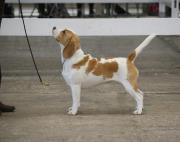
Deaconfield Beagles
Contact me ........
Debbie Taylor
debbie_deaconfield@outlook.com
UPDATED: 19th September 2025
UPDATED: 25th october 2025
25th October 2025